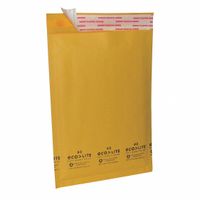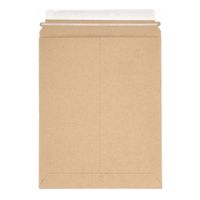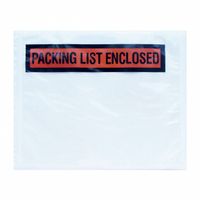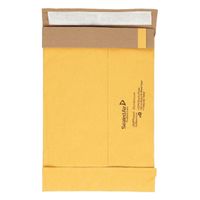Call +(254) 703 030 000 / 751 483 999 / 721 704 777
- Home
- Packaging Shipping
- Shipping Mailers Envelopes
.....Read More
Frequently Asked Questions
What are the standard sizes for mailing envelopes?
Mailing envelopes come in a variety of standard sizes, each designed to accommodate different types of documents and mailing needs. Here are some of the most common sizes:
1. **#10 Envelope**: Measuring 4 1/8 x 9 1/2 inches, this is the most widely used size for business correspondence. It fits a standard 8 1/2 x 11-inch sheet of paper folded into thirds.
2. **#9 Envelope**: Slightly smaller at 3 7/8 x 8 7/8 inches, this size is often used as a return envelope and fits inside a #10 envelope.
3. **A2 Envelope**: With dimensions of 4 3/8 x 5 3/4 inches, this size is commonly used for invitations, greeting cards, and small notecards.
4. **A6 Envelope**: Measuring 4 3/4 x 6 1/2 inches, it is suitable for invitations and greeting cards, providing a bit more room than the A2.
5. **A7 Envelope**: At 5 1/4 x 7 1/4 inches, this size is popular for larger invitations and greeting cards.
6. **6x9 Envelope**: This size, measuring 6 x 9 inches, is often used for mailing booklets, brochures, and larger documents without folding.
7. **9x12 Envelope**: Measuring 9 x 12 inches, it is ideal for sending standard-sized documents flat, such as reports and presentations.
8. **10x13 Envelope**: At 10 x 13 inches, this size is used for larger documents and materials that need to be mailed flat without folding.
These standard sizes ensure compatibility with postal systems and provide options for various mailing requirements, from personal correspondence to professional documents.
How do I choose the right envelope for shipping?
To choose the right envelope for shipping, consider the following factors:
1. **Size and Weight**: Match the envelope size to the contents. Use a snug fit to prevent movement but ensure it's not overstuffed. Check weight limits for different envelope types to avoid extra charges.
2. **Material**: Choose the material based on the item's fragility. Paper envelopes are suitable for documents, while padded or bubble mailers offer protection for fragile items. Tyvek envelopes are durable and water-resistant, ideal for important documents.
3. **Protection**: For delicate items, opt for padded envelopes with bubble wrap or foam lining. For documents, consider rigid mailers to prevent bending.
4. **Closure Type**: Select a secure closure to prevent tampering. Options include self-sealing, peel-and-seal, or clasp closures. For high-security needs, consider tamper-evident envelopes.
5. **Cost**: Balance cost with protection needs. Lightweight envelopes reduce shipping costs, but ensure they provide adequate protection.
6. **Environmental Impact**: Consider eco-friendly options like recycled materials or biodegradable envelopes if sustainability is a priority.
7. **Destination**: For international shipping, ensure the envelope meets postal regulations of the destination country. Consider customs requirements and potential delays.
8. **Branding**: If branding is important, choose envelopes that allow for customization with logos or designs.
9. **Quantity**: Buying in bulk can reduce costs if you frequently ship items.
10. **Special Features**: Consider envelopes with features like tear strips for easy opening or gussets for expanding capacity.
By evaluating these factors, you can select an envelope that ensures safe, cost-effective, and efficient shipping.
What materials are mailing envelopes made from?
Mailing envelopes are made from a variety of materials, each chosen for specific properties that suit different mailing needs. The most common materials include:
1. **Paper**: Standard envelopes are typically made from paper, which can range from lightweight to heavy-duty. Kraft paper, known for its strength and durability, is often used for larger envelopes. Recycled paper is also popular for its environmental benefits.
2. **Cardboard**: Used for rigid mailers, cardboard provides extra protection for documents and items that should not be bent or folded. These are often used for photographs, certificates, and important documents.
3. **Plastic**: Poly mailers are made from polyethylene, a type of plastic that is lightweight, waterproof, and tear-resistant. These are commonly used for shipping clothing and other non-fragile items.
4. **Bubble Wrap**: Bubble mailers combine a paper or plastic exterior with a bubble wrap interior, offering cushioning for fragile items. They are ideal for shipping small electronics, jewelry, and other delicate items.
5. **Tyvek**: A brand of synthetic material made from high-density polyethylene fibers, Tyvek envelopes are lightweight, durable, and resistant to moisture and tearing. They are often used for important documents and items requiring extra protection.
6. **Padded**: Padded envelopes have an interior lining of padding material, such as recycled paper fibers or foam, providing additional protection for the contents. They are suitable for shipping items that need cushioning but are not extremely fragile.
These materials are selected based on factors like durability, weight, cost, and environmental impact, ensuring that the envelopes meet the specific requirements of different mailing tasks.
How much does it cost to ship items in mailing envelopes?
The cost to ship items in mailing envelopes depends on several factors, including the size and weight of the envelope, the shipping service chosen, the destination, and any additional services like tracking or insurance.
1. **Size and Weight**: Most postal services have specific categories for mailing envelopes, such as standard, large, or oversized. The weight of the envelope also plays a crucial role, with costs increasing as weight increases.
2. **Shipping Service**: Different services offer various pricing structures. For example, the United States Postal Service (USPS) offers First-Class Mail for lightweight items, Priority Mail for faster delivery, and Priority Mail Express for overnight service. Each has different pricing tiers.
3. **Destination**: Domestic shipping is generally cheaper than international shipping. Costs can vary significantly based on the destination country and the specific postal zones involved.
4. **Additional Services**: Adding services like tracking, insurance, or signature confirmation will increase the cost. These services provide added security and peace of mind, especially for valuable or important items.
5. **Carrier**: Different carriers have different pricing models. Besides USPS, other options include FedEx, UPS, and DHL, each offering various services and pricing.
6. **Flat Rate Options**: Some services offer flat-rate envelopes, where you pay a fixed price regardless of weight, as long as it fits in the envelope. This can be cost-effective for heavier items.
In summary, the cost can range from a few dollars for a simple domestic First-Class Mail envelope to significantly more for expedited or international services with additional features. Always check with the specific carrier for the most accurate and up-to-date pricing.
Are poly mailers better than paper envelopes for shipping?
Poly mailers and paper envelopes each have their advantages and disadvantages when it comes to shipping, and the choice between them depends on specific needs and circumstances.
Poly mailers are made from durable, lightweight plastic, making them resistant to tears, moisture, and punctures. This durability is particularly beneficial for shipping non-fragile items like clothing, textiles, or soft goods. Their lightweight nature can also reduce shipping costs, especially for bulk shipments. Additionally, poly mailers often come with self-sealing adhesive strips, which simplify the packaging process and enhance security. They are also available in various sizes and can be customized with branding, which is advantageous for businesses looking to enhance their brand visibility.
On the other hand, paper envelopes are more environmentally friendly, as they are biodegradable and often made from recycled materials. They are suitable for shipping documents, photographs, or other flat items that do not require significant protection. Paper envelopes are also easy to write on, which can be convenient for labeling. However, they are less durable than poly mailers and can be susceptible to tearing and moisture damage, making them less ideal for shipping items that need more protection.
In summary, poly mailers are generally better for shipping items that require durability and protection from the elements, while paper envelopes are more suitable for flat, lightweight items and are a more eco-friendly option. The decision should be based on the nature of the items being shipped, cost considerations, and environmental impact preferences.
How do I properly seal a mailing envelope?
To properly seal a mailing envelope, follow these steps:
1. **Choose the Right Envelope**: Ensure the envelope is the correct size for your contents. Overstuffing can lead to poor sealing.
2. **Prepare the Contents**: Neatly fold and insert the contents into the envelope. Ensure they fit comfortably without bulging.
3. **Moisten the Seal**: If the envelope has a gummed seal, lightly moisten it. Use a damp sponge or a moistening tool to avoid over-wetting, which can weaken the adhesive.
4. **Press Firmly**: Align the flap with the envelope's edge and press down firmly. Use your fingers or a flat object to ensure even pressure across the seal.
5. **Reinforce the Seal**: For added security, especially for important documents, use clear tape or a sealing sticker over the flap. This prevents accidental opening during transit.
6. **Check for Gaps**: Inspect the seal for any gaps or areas that didn’t adhere properly. Re-moisten and press again if necessary.
7. **Label Clearly**: Ensure the address and return address are clearly written or printed on the envelope. Use a permanent marker or pen that won’t smudge.
8. **Postage**: Affix the correct postage. If unsure, weigh the envelope and check postal rates to avoid underpayment.
9. **Secure Additional Items**: If sending bulky or valuable items, consider using a padded envelope or additional packaging for protection.
10. **Final Inspection**: Before mailing, double-check that the envelope is securely sealed and all information is correct.
By following these steps, you ensure your envelope is properly sealed and ready for mailing, minimizing the risk of it opening during transit.
Can I ship fragile items in mailing envelopes?
Shipping fragile items in mailing envelopes is generally not recommended due to the lack of protection they offer. Mailing envelopes, especially those made of paper or thin plastic, do not provide adequate cushioning or support to prevent damage during transit. Fragile items are susceptible to breakage from impacts, pressure, and rough handling, which are common in the shipping process.
If you must use an envelope, consider padded or bubble mailers, which offer some degree of protection with their built-in cushioning. However, even with padded envelopes, the level of protection is limited compared to boxes. For added safety, wrap the fragile item in bubble wrap or foam padding before placing it in the mailer. Ensure the item is snugly fit to minimize movement.
For highly fragile or valuable items, using a sturdy box is a better option. Boxes can accommodate additional protective materials like packing peanuts, air pillows, or crumpled paper, providing a buffer against shocks and vibrations. Double-boxing, where the item is placed in a smaller box within a larger one, can offer extra protection.
Labeling the package as "Fragile" can alert handlers to take extra care, but it does not guarantee gentle handling. Consider purchasing insurance for valuable items to cover potential damage during shipping.
In summary, while it is possible to ship fragile items in mailing envelopes, it is not advisable due to the risk of damage. Opt for padded mailers or, preferably, sturdy boxes with ample cushioning to ensure the safe delivery of fragile goods.
What is the weight limit for items shipped in mailing envelopes?
The weight limit for items shipped in mailing envelopes varies depending on the postal service and the type of mailing service chosen. For the United States Postal Service (USPS), the weight limit for First-Class Mail letters is 3.5 ounces. If the item exceeds this weight, it may be classified as a large envelope (also known as a flat) or a package, which have different weight limits and pricing structures.
For USPS First-Class Mail large envelopes (flats), the maximum weight is 13 ounces. If the item exceeds 13 ounces, it must be sent via Priority Mail or another service. Priority Mail envelopes have a weight limit of 70 pounds, but this is generally applicable to larger packages rather than standard mailing envelopes.
For international shipping, the weight limits can differ. For example, USPS First-Class Mail International letters have a weight limit of 3.5 ounces, while large envelopes (flats) can weigh up to 4 pounds. Other international services, like Priority Mail International, allow for heavier items, with weight limits varying by destination country.
Private courier services like FedEx and UPS also have their own weight limits and guidelines for mailing envelopes. FedEx Express envelopes, for instance, have a weight limit of 10 pounds, while UPS Express Envelopes are limited to 8 ounces for documents, but can accommodate up to 70 pounds if using UPS Express Pak for non-document items.
It's important to check with the specific postal or courier service being used to ensure compliance with their weight limits and guidelines, as exceeding these limits can result in additional charges or the need to use a different service.
How do I address a mailing envelope correctly?
To address a mailing envelope correctly, follow these steps:
1. **Recipient's Address**:
- Write the recipient's full name on the first line.
- On the second line, write the street address. Include apartment or suite number if applicable.
- On the third line, write the city, state (or province), and ZIP code (or postal code). Use the two-letter state abbreviation for U.S. addresses.
- For international addresses, include the country name on the last line in capital letters.
2. **Return Address**:
- In the top left corner, write your full name on the first line.
- On the second line, write your street address.
- On the third line, write your city, state, and ZIP code.
3. **Postage**:
- Place the correct postage stamp in the top right corner of the envelope. Ensure it covers the required postage for the weight and destination of the mail.
4. **Formatting Tips**:
- Use a pen with dark ink for clarity.
- Print clearly in capital letters to ensure readability.
- Avoid punctuation marks in the address, except for the hyphen in the ZIP+4 code.
- Align the address to the left and keep it centered on the envelope.
5. **Special Considerations**:
- For business or formal letters, you may include the recipient's title or company name.
- If using a window envelope, ensure the address is visible through the window.
By following these guidelines, you ensure that your mail is processed efficiently and reaches its intended destination without delay.
Are there eco-friendly options for mailing envelopes?
Yes, there are several eco-friendly options for mailing envelopes. These options focus on sustainability, recyclability, and reducing environmental impact:
1. **Recycled Paper Envelopes**: Made from post-consumer waste, these envelopes reduce the need for virgin paper and help in minimizing deforestation. They are often recyclable and biodegradable.
2. **Kraft Paper Envelopes**: Produced from natural, unbleached wood pulp, kraft paper envelopes are strong, durable, and biodegradable. They can be recycled multiple times.
3. **Biodegradable Plastic Envelopes**: Made from plant-based materials like corn starch, these envelopes decompose naturally, reducing plastic waste.
4. **Compostable Envelopes**: These are designed to break down in composting conditions, made from materials like PLA (polylactic acid) derived from renewable resources.
5. **Reusable Envelopes**: Designed for multiple uses, these envelopes often have resealable closures, reducing the need for single-use envelopes.
6. **Water-Based Inks and Adhesives**: Envelopes using water-based inks and adhesives are less harmful to the environment compared to those using solvent-based options.
7. **Carbon-Neutral Envelopes**: Some companies offer envelopes that offset their carbon footprint through various environmental projects, making them a more sustainable choice.
8. **FSC-Certified Envelopes**: Envelopes with the Forest Stewardship Council certification ensure that the paper is sourced from responsibly managed forests.
9. **Envelope Liners from Recycled Materials**: Some envelopes come with liners made from recycled materials, adding an extra layer of sustainability.
Choosing eco-friendly mailing envelopes not only supports environmental conservation but also aligns with sustainable business practices, appealing to environmentally conscious consumers.




